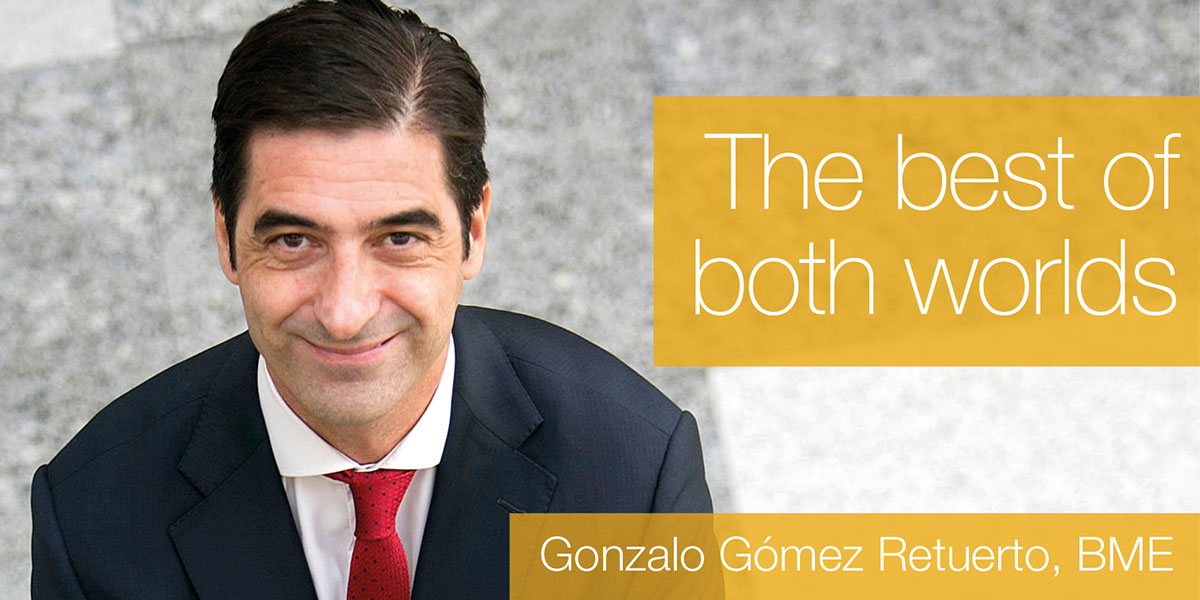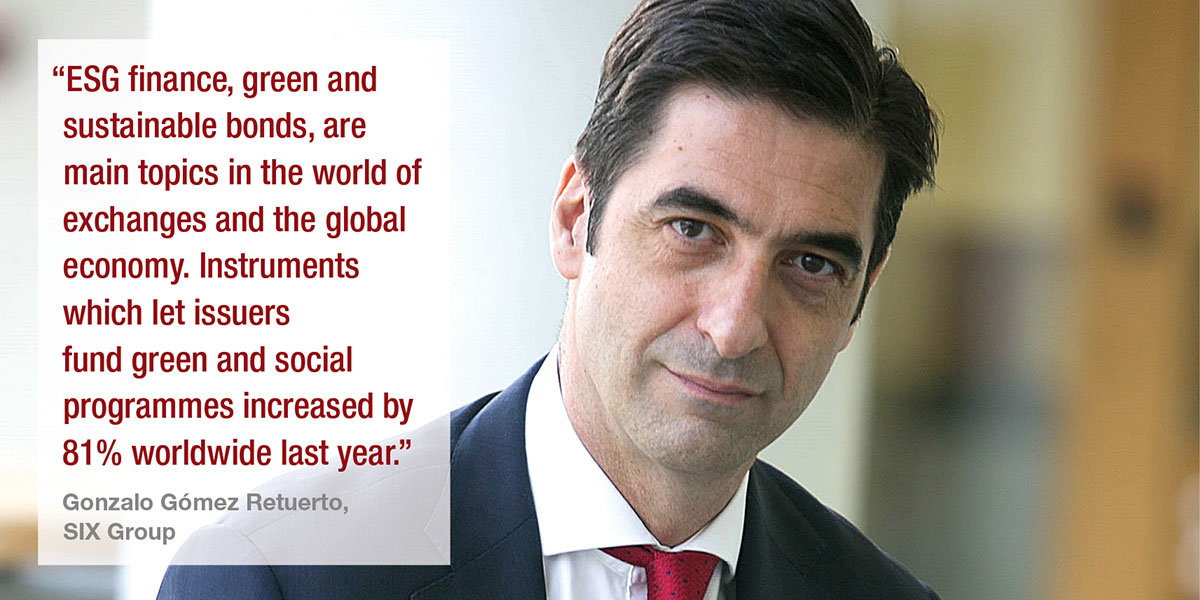Gonzalo Gómez Retuerto, Head Fixed Income and MARF (Mercado Alternativo de Renta Fija) at SIX Group’s BME talks about plans for SMEs, ESG and integration.
How is the integration with the SIX Group progressing?
A lot of work has gone into integrating BME and SIX into one company. We are working together on several projects as well as looking at new ideas and products. In fixed income, BME who manages the fixed income systems in Spain, has three main business units – the MARF, AIAF, Spain’s regulated benchmark market for corporate debt and private fixed income and SENAF (Sistema Electrónico de Negociación de Activos Financieros), and BME’s electronic trading platform for Treasury debt.
We are also working closely with customers to offer them access to new sources of finance and capital. One of the main advantages from a Spanish point of view is the international profile that the acquisition has given us. It enables us to expand our business from a jurisdictional as well as product perspective.
Can you provide some more detail of MARF?
One of our main focuses is to promote deeper markets for SMEs (small to medium sized enterprises) by making it easier and cheaper for them to list fixed income securities. We are hoping to reduce their dependency on bank funding which is the main source in Europe. Non-bank funding accounts for around 24% of corporate financing whereas in the US the figure is 73%. We want MARF to be the mechanism for financing and supporting the growth of companies. We like to work closely with companies and help them move from the growth to the main market over time. To this end, we are providing more education to the full range of participants about the market and have also been organising regular public events with companies, regulators and key stakeholders promoting the depth and liquidity of the market as well as publishing news reports in the media.
Since its launch at the end of 2013, over 108 new issuers have listed on MARF. Total listed volume for the first half of 2021 was over €5bn, up 17% compared with the first 6 months of 2020 and the volume outstanding is close to €6.5bn; 22% higher than the figure we had in the same dates last year. We saw a drop off last March and April during Covid, but they recovered quickly with issues totalling €9.6bn last year, a 7% drop from 2019. At year-end 2020, the total amount outstanding on the MARF stood at €5.3bn, up 3.8% on 2019.
A new trend that we have seen is that several mid-range companies are issuing green bonds. If you asked me whether that would have happened ten years ago, I would have said that was not possible but today it is a clear trend which I think will continue.
In general, what are the developments in ESG at BME?
ESG finance, green and sustainable bonds, are main topics in the world of exchanges and the global economy. Instruments which let issuers fund green and social programmes increased by 81% worldwide last year and SIX and BME are actively engaged in supporting a wide range of issuers including governments, public entities and private sector, in their sustainability goals. As a group we have expanded our capabilities and opportunities in the sustainability market. We are educating investors and collaborating in international working groups where standards for this type of security are being developed.
Spain is among the ten most active jurisdictions in the ESG bonds issuance world rankings and we have provided a platform for companies ranging from the telecommunications company Telefónica and banks such as BBVA, Santander and CaixaBank to the railroad infrastructure manager ADIF, as well as many public institutions to come to the market to fund their energy transition.
How do you see this trend evolving?
I think we will continue to see more and more issuance from companies and the public sector because there is a huge demand from investors. There is also a greater premium in issuing green bonds because of their lower volatility and strong performance against non ESG assets. Issuers also like the fact that they are helping promote the use of the green economy. This growing interest in ESG comes as the EU introduced its Sustainable Finance Disclosure Regulation (SFDR), which requires institutions to disclose how they incorporate sustainability into their investment processes, is being implemented.
There are concerns over greenwashing. How do you avert these issues?
Green Bonds have an independent auditor who looks at the characteristics of the bond and provide an external assessment of the risks. Also, as an exchange we are actively involved in setting up industry standards, providing transparency and information around ESG bonds. We encourage issuers to report non-financial ESG information in their periodic reports and as mentioned also work with several international groups. We have been a member of the Sustainable Stock Exchanges since 2015. The aim is to raise awareness of best corporate governance and social and corporate responsibility practices and to foster sustainable business practices.
How has use of technology changed and what innovative projects are being developed?
Fixed income has been traditionally traded OTC or bilateral via phone, but I would say over the last 15 to 20 years, there has been a greater move to electronic trading especially with the highly liquid bonds. Although it is not happening as quickly as with government bonds, we have several international names listed on our exchange and I think that will continue.
As for innovation, technology is very important in our group, and we are very active in the digital space. Our SDX, or SIX Digital Exchange, recently received FINMA approval to operate a stock exchange and a central securities depository for digital assets in Switzerland.
You have outlined the opportunities but what do you see as the challenges?
In ESG, it is regulation and making sure we keep up with all the developments. For example, there are standards being developed by groups such as ICMA as well as the European Union’s Taxonomy and SFDR from a public perspective. However, there are also existing regulations such as MiFID which promote transparency and best execution in all asset classes that are challenging for fixed income. We are now looking at what we will need to do to adapt to any changes in the MiFID review.
We are also looking at the impact of the tapering plans of central banks such as the European Central Bank and US Federal Reserve. We have seen the biggest bond buying programme during Covid and now we are interested in how the tapering will be done, the speed, assets impacted and the demand – all key elements of investing.
Gonzalo Gómez Retuerto, Head Fixed Income and MARF (Mercado Alternativo de Renta Fija) at BME, which was acquired by SIX Group in 2019. He has built his professional career in the financial sector, particularly in the area of capital markets and fixed income securities, at AIAF Mercado de Renta Fija at Grupo BME. In July 2013 Gonzalo was appointed Head Fixed Income, where he is responsible for launching and managing MARF, the new financing platform for private companies.
©Markets Media Europe 2021
[divider_to_top]
































































































